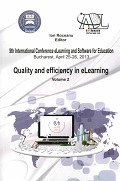COLLABORATIVE AUTHORING AND MEASURING THE AUTHOR'S TEAM ASSESSMENT IN AN E-LECTURING ENVIRONMENT - A CASE STUDY
COLLABORATIVE AUTHORING AND MEASURING THE AUTHOR'S TEAM ASSESSMENT IN AN E-LECTURING ENVIRONMENT - A CASE STUDY
Author(s): Irina Zheliazkova, Adriana Naydenova BorodzhievaSubject(s): Education
Published by: Carol I National Defence University Publishing House
Keywords: Authoring; Measuring; Assessment; E-Testing; Web-Based Teaching Systems
Summary/Abstract: The traditional course materials (lectures, tests, exercises, instructions, and so on) in higher education are often results of the teaching team's work. At this stage of the field of the web-based teaching systems and in comparison with the collaborative learning the literature found mainly in INTERNET (Bauwens & Hourcade, 1997; Flanagan, 2001; Corwin, 2004) is little but with an increasing trend of interest. With this connection the collaborative authoring and measurement of the author's team assessment also presents a research issue from both theoretical and practical points of view. With this aim in parallel of the previous study another natural experiment has been carried out at Ruse University with the same participants. The experimental results are presented and discussed in this paper structured as follows: 1) A detail description of the experiment's organization, in which the author of the lecture notes in "Intelligent Teaching Systems" was playing the instructor's role, and the participant students ? the author's role; 2) The structure and content of the word document with lecture notes given to the students; 3) Short instructions for their uploading by means of the authoring tool of the e-lecturing subsystem by each student; 4) Raw data including time and collected in an Excel table for this first stage; 5) Raw data including time and collected in an Excel table for the next teams working stage; 6) Proposed analytical model for the author's team assessment and its graphical interpretation; 7) Verification of the model computing the correlation with the six-points scale mark, given by the instructor, and 8) Benefits of embedding the proposed model in the authoring tool for electuring.
Journal: Conference proceedings of »eLearning and Software for Education« (eLSE)
- Issue Year: 9/2013
- Issue No: 02
- Page Range: 41-47
- Page Count: 7
- Language: English

